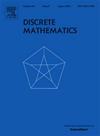On odd and strong odd colorings of graphs
IF 0.7
3区 数学
Q2 MATHEMATICS
引用次数: 0
Abstract
An odd k-coloring of a graph G is a proper k-coloring such that for every non-isolated vertex v there is a color that occurs an odd number of times in the neighborhood of v. A strong odd k-coloring of G is a proper k-coloring such that for every vertex v every color occurs an odd number of times or 0 times in the neighborhood of v, which is a strengthened version of odd coloring and also a relaxation of square coloring. The odd chromatic number (or the strong odd chromatic number) of a graph G, denoted by (or ), is the minimum number of colors in any odd coloring (or strong odd coloring) of the graph G. In this paper, we prove that for any and , there exists a such that if and , then , where is the chromatic number of G, and are the maximum degree and minimum degree of G respectively. In addition, we construct a planar graph with strong odd chromatic number 13, which answers a question asked by Caro, Petruševski, Škrekovski and Tuza in negative.
论图的奇、强奇着色
奇数k-coloring图G是一个适当的k-coloring这样每non-isolated顶点v有颜色出现奇数次诉强大的邻居奇怪k-coloring G是一个合适的k-coloring这样的每一个顶点v颜色出现奇数倍或0 * v的社区,这是一个加强版的奇怪的着色和广场的放松的颜色。奇怪的彩色数字(或强烈的奇怪的彩色数字)的图G,用χo (G)(或χ(G)),是最低数量的颜色在任何奇怪的着色图的(或强烈的奇怪的着色)G .在这篇文章中,我们证明任何ϵ1在0和2ϵ∈(0,1),存在一个Δ(ϵ1,ϵ2),这样如果Δ(G)≥Δ(ϵ1,ϵ2)和δ(G)≥Δ(G) 12 +ϵ1,然后o (G)≤χχ(G) +⌈ϵ2Δ⌉(G),在χ(G)是彩色的G和Δ(G),δ(G)分别为最大程度和最小程度的G。此外,我们构造了一个强奇色数为13的平面图,否定地回答了Caro、Petruševski、Škrekovski和Tuza提出的问题。
本文章由计算机程序翻译,如有差异,请以英文原文为准。
求助全文
约1分钟内获得全文
求助全文
来源期刊

Discrete Mathematics
数学-数学
CiteScore
1.50
自引率
12.50%
发文量
424
审稿时长
6 months
期刊介绍:
Discrete Mathematics provides a common forum for significant research in many areas of discrete mathematics and combinatorics. Among the fields covered by Discrete Mathematics are graph and hypergraph theory, enumeration, coding theory, block designs, the combinatorics of partially ordered sets, extremal set theory, matroid theory, algebraic combinatorics, discrete geometry, matrices, and discrete probability theory.
Items in the journal include research articles (Contributions or Notes, depending on length) and survey/expository articles (Perspectives). Efforts are made to process the submission of Notes (short articles) quickly. The Perspectives section features expository articles accessible to a broad audience that cast new light or present unifying points of view on well-known or insufficiently-known topics.
 求助内容:
求助内容: 应助结果提醒方式:
应助结果提醒方式:


